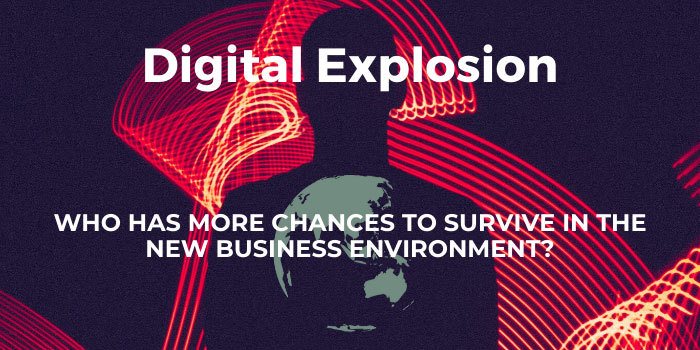Digital technologies revolutionized the world so quickly that many individuals and organizations had a big problem to adapt and embrace the new models of work. Today, it is almost impossible to imagine a serious professional without a smartphone or a profitable business not using cutting-edge tools and programs.
Digital platforms are recasting the relationships between customers, workers, and employers as the silicon chip’s reach permeates almost everything we do - from buying groceries online to finding a partner on a dating website.

It is one of the most drastic changes that human civilization has ever witnessed and it all took place in the last three decades. Being such an overwhelming process, we can’t help but ask ourselves a few questions:
- What makes this digital revolution?
- How does it affect entire industries all over the globe?
- What are its pros and cons?
- Who has more chances to survive the digital explosion and stay competitive in the new business environment?
If you want to see the answers to these questions, make sure to keep reading!
Digital Revolution: Definition, Stats, and Influences
The first thing we need to discuss is the very definition of the phrase “digital revolution.” There are many ways to explain the concept, but we’ll stick to good old Wikipedia.

By definition, the Digital Revolution is the shift from mechanical and analog electronic technology to digital electronics which began anywhere from the late 1950s to the late 1970s with the adoption and proliferation of digital computers and digital record keeping that continues to the present day.
If you want to make things simpler, we can give you a shorter version – the digital revolution represents the tendency to use state of the art technologies in order to do more things much faster and more efficiently. In case you need examples, here are just a few:
- There are approximately 6.5 billion smartphones currently in use around the world.
- Almost 90% of shoppers read online reviews before buying a product.
- Around 50% of businesses now use Artificial Intelligence (AI) to grow sales.
You can find many more stats online, but let’s move on and check out some real-life examples of how the digital explosion is affecting the business environment. The list of examples is almost endless, so we will narrow down the options and show you only a handful:
1. Customer relationship management

Every entrepreneur understands the importance of customer relationship management (CRM), which is why so many companies rely on digital technologies to improve their services. One of the best examples comes in the form of chatbots, AI agents that make CRM simple and constantly available.
Hundreds of thousands of service websites chatbots to ensure maximum availability for their clients. Only one chatbot platform can now successfully replace dozens of customer service representatives.
2. Education

New technologies found a way to revolutionize education as well. Lifelong learning has become a real deal in the last few years, with 55% of full- or part-time workers say they participated in work or career learning to maintain or improve their job skills.
A great example comes directly from the OR room, where new practitioners use Virtual Reality to exercise and learn how to deal with emergency situations. This is only one of the brightest examples, but it’s obvious that the potential in the field of education has no limits.
3. Digital marketing

Do you know that content marketing generates over three times as many leads as traditional marketing strategies and costs 62% less? New technologies gave marketing a huge boost and helped it to become better, more accurate, and extremely effective.
Nothing more than simple website analytics now makes it possible to understand how your audience thinks, feels, and behaves. In such circumstances, creating a tailored offer becomes as easy as it gets.
4. Pricing deals

Do you know how flight prices on airline websites keep changing minute after minute? That’s just technology doing its thing. Businesses can use clever machines for real-time price adjustments to make the most of their products or services.
The Pros and Cons of the Digital Explosion
New technologies are making a strong impact on modern businesses, but the trend is not so lopsided after all. There are a few side effects that we have to mention, but let’s start with the practical benefits of the digital revolution.
You’ve seen the pros, but now it’s time to discuss the cons of the digital revolution as well. Here are the most significant downsides of the process:
The Bottom Line
The digital revolution is changing almost every segment of our personal and professional lives, so only the most agile individuals and organizations are able to withstand the pressure and stay competitive long-term.
Who can survive the new business environment?
The answer is simple – companies that embrace new technologies and learn how to make the most of it will outclass competitors in the nearest future. On the other hand, organizations that still prefer repetitive and manual work will disappear slowly and painfully.
Which side are you on?

Justin Osborne is a freelance writer who loves to share his thoughts and opinions about education, writing and blogging with other people on different blogs and forums. Currently, he is working as a content marketer.
Author // Justin Osborne
